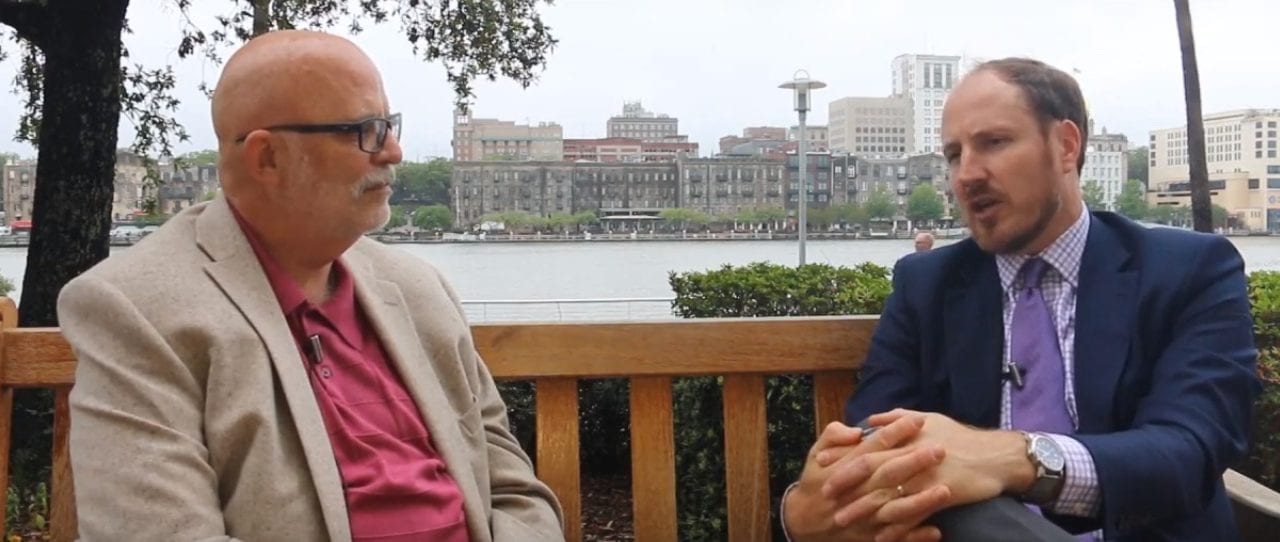Steve recently caught up with Ryan Fredericks at the last Environments for Aging conference in Savannah, Georgia.
By Susan Saldibar
I have to admit that the first thought I had while watching Steve Moran’s podcast with Ryan Fredericks of Smart Living 360 was, “Wow, they’ve built a Utopia.” Seriously, this is a really cool new housing concept and you really should watch the entire podcast, which you can access here.
Steve caught up with Ryan at the last Environments for Aging conference in Savannah, Georgia, where Ryan Fredericks was the keynote speaker.
Steve asked Ryan to talk about Smart Living 360 and how they are doing their best to disrupt the industry. They completed their first project last year in downtown Rockville, Maryland. Called The Stories, the new 45-unit building is located right in the middle of Rockville’s Congressional Plaza. And, how’s this for disruption: There are no age restrictions. Their tenants range from millennials to 90-year olds (who Ryan refers to as “grown-ups”). The philosophy is that grown-ups, like everyone else, crave a more authentic sense of community; something you don’t get in traditional senior living environments surrounded only by other grown-ups. It’s a model that allows a 90-year old woman to live in an apartment with her thirty-something caregiver living right next door. And the building itself is state of the art with attractive, universal design elements and technology geared to support aging tenants.
“We look for people who want to know their neighbors.”
What you won’t see at The Stories are CNAs walking up and down the halls. Instead, Smart Living 360 employs a full time “ambassador” in the building, whose role is, according to Ryan, part life coach, part problem solver, and part concierge. They can help connect people to different services as they need them.
But for this model to work, you need to be able to attract the kinds of people who like to engage with those around them; people who tend to look out for each other. A special questionnaire, provided along with each rental application, helps identify these people. “We look for people who want to know their neighbors,” Ryan tells Steve. “Of course, we won’t refuse someone who just wants to move in. But we make it clear what the ‘ethos’ of this is,” he adds.
And this “ethos” wasn’t pulled from thin air. Much of it came out of a series of focus groups, many conducted by students at Hopkins and U of Virginia from “design thinking” programs. They went into people’s homes to understand the psychographics of what people are looking for. Some of it was obvious and some a lot more subtle.
According to Ryan, there are things that even traditional senior loving operators can take away from the Smart Living 360 project. “There’s room for a new model of living involving a non-age-restricted environment,” Ryan explains to Steve. And, he believes it can be offered at a lower price point by removing some of the elements that drive costs up for operators and replacing them with alternative ways of empowering people and leveraging technologies and other resources.
A “craving for community” across age groups and incomes.
Steve asked what some of the lessons learned have been for Ryan after completing this initial project. His reaction is “Tons!”
“We learned that there is a subset of people who are looking for something different, Ryan says. “There is this craving for community that crosses age groups and incomes. A community of unique people with stories that continue to evolve as we add chapters to lives.”
But he’s also quick to admit that explaining all this is much more complicated than just “come move into an apartment.” There needs to be a different way to market and handle the leasing process. And part of the answer, Ryan believes, lies in being very intentional about creating culture, letting people know what you’re about, and reinforcing your values.
“So, what does the future hold?” Steve asked.
“My hope for the project and the future is that fewer and fewer people see themselves in the “senior living” business,” Ryan says. “And that more see themselves in the business of creating environments to help people thrive across their lifespans.”
Steve agrees, having written before about the need for this industry to ask itself what business it’s really in. “Unfortunately, from an operator and capital standpoint, I think it’s still seen primarily as the real estate business,” Steve says. “So, I like hearing ‘we’re in the lifestyle business for grown-ups’.”
And if we end up creating Utopias, so much the better.








